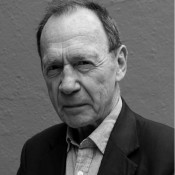Whitehot Magazine
December 2025
"The Best Art In The World"
"The Best Art In The World"
December 2025
Pictures from a Pandemic: Ashley Bickerton Talks to Anthony Haden-Guest
 Ashley Bickerton, Floating Ocean Chunk To Be Hauled Up Mountain High Desert, Forest No.1
Ashley Bickerton, Floating Ocean Chunk To Be Hauled Up Mountain High Desert, Forest No.1
By ANTHONY HADEN-GUEST October 8, 2020
Ashley Bickerton’s father, a scholar in pidgin languages, was much on the move and Bickerton was born in Barbados in 1959, grew up in Hawaii. He went to the California Institute of Arts, then to New York in 1982, where he cut a robust figure in the East Village art world, and was in an attention-getting 1986 show at Sonnabend with Peter Halley, Meyer Vaisman and Jeff Koons. The work he was making was agile in the use of techniques, references and materials, such as found objects, and often darkly witty. BAD is made up from silhouettes of, for instance, a handgun, a cobra about to strike and a swastika, his Tormented Self Portraits are put together from such commercial logos as that of The Village Voice, Marlborough Cigarettes and his invention, Susie. Other razor-edged pieces are those upon which were bedded screens keeping viewers/collectors abreast of the value of the piece.
Ashley Bickerton’s work changed profoundly when he moved to Bali, Indonesia, in 1993. The paintings and sculpture became more figural but hardly placidly so. A sculpted self-portrait is actually that but it is painted green and fixed onto a spike that also penetrates a number of boulders and a number of painted females have a rainbow skin and manic eyes. The title of a 2017 show of a quarter century of Bickerton’s work at London’s Newport Gallery was well chosen: Ornamental Hysteria. Bickerton’s work is now undergoing a further development, and a striking one. The East Village art world where he first came to attention partly defined itself by its opposition to SoHo, indeed the whole Neo-Expressionist phenomenon, painterliness being very much on the shit list. Neo Geo was not big on brushwork, neither was Ashley Bickerton but now .... well, enough from me. I’ll let him take it from here.
 Ashley Bickerton, Flotsam Painting, Sky/Ground 3
Ashley Bickerton, Flotsam Painting, Sky/Ground 3
From Ashley Bickerton:
I first got the idea for my new ‘Flotsam Series’ a couple of years back when my wife and I hiked down to the beach at the base of the cliffs just near my house in Bali. When we arrived in the middle of the day it was high tide and the waves were smashing up against the base of the cliffs in many places. Throughout the afternoon the tide receded and as I sat there lost in the reverie of the moment, I suddenly saw it all around me. It was certainly a Eureka moment. All up and down the beach as the tide had ebbed, each receding wave had left long undulating lines of both organic and human made detritus. This ocean borne detritus, or flotsam, was laid out in the vestigial formations of the waves that washed them onto the shore as the tide receded. It said everything I wanted to say and I knew I could run with it. The question then became, run where?
I have spent over three years working through a variety of approaches to this one idea. How best to communicate it. There were so many possible approaches, and the storage basement in my studio is testimony to the abundance of failures. The first successes were the mirrored vector boxes, which I love and will continue to make. But they still had one major issue baked in. Much of their production relied on farmed out fabrication. I had left New York all those years ago in large part because I wanted to be much more hands on with the work, and not be at the mercy of external fabricators, their whims, and their schedules. So keeping the same flotsam tide line idea, I applied the structure to handmade highly chromatic paintings. This approach also fostered an enormous amount of trial and error, stress on the error, but I finally feel I have come to terms with the language. It is an oddly happy time making this body of dark work in the midst of a global pandemic, and I am certain that I could be very happy making these in some variation or other till the clock runs out.
 Flotsam Painting, After Albert Pinkham Ryder.
Flotsam Painting, After Albert Pinkham Ryder.
In this new painted series, I am obsessed with a simplified earth/sky binary, matter and emptiness, and keep returning to it in a variety of incarnations. (Actually, throughout my career it has been an omnipresent lynchpin). I look a lot to the paintings of Milton Avery, JMW Turner, and Yves Tanguy etc to help me feel my way through this duality. Salvador Dali also made great use of the earth and sky to set the tone for his particular theatrics. The dots that make up a large part of the undulating wave lines represent micro plastics disgorged from the great oceanic gyres and now deposited back onto the margins of the anthroposphere from whence they originally came.
When I think about these pieces, I think of words and terms like flotsam, borderless oceanic detritus, seascapes, culturescapes, swirling cosmologies of micro plastics, fragments of human narratives, residues of lives lived, of vestiges of human presence now swirling in great molecular vortexes. Landscape and seascape is where I have always been happiest. Culturescapes are fun, but ultimately too hectic and too noisy. I long for great silence and great emptiness.
 Ashley Bickerton, Flotsam Painting (Fire Ridge).
Ashley Bickerton, Flotsam Painting (Fire Ridge).
It would be a mistake to assume these works are bemoaning the destruction of our home planet. I do not think of myself as an environmentalist, as being an environmentalist is to labor under the assumption that you are preserving the planet for human habitation. We as a species cannot destroy the planet, it is ever resilient and adaptive, and far bigger than us, but what we are certainly capable of is destroying its ability to support us as a species. After all our follies, I simply don’t believe we deserve this planet, and steadfastly side with it over the interests of our human struggle to maintain our niche in this brief period of human involvement. I also do not see the billions of tons of ocean borne plastic flotsam as ugly, I see it as both beautiful, and as much a part of the natural order as the migration of Wildebeest in the Serengeti. The planet will persist long after we are gone, our human residue just one more component in a fantastic complexity. WM

Anthony Haden-Guest
Anthony Haden-Guest (born 2 February 1937) is a British writer, reporter, cartoonist, art critic, poet, and socialite who lives in New York City and London. He is a frequent contributor to major magazines and has had several books published including TRUE COLORS: The Real Life of the Art World and The Last Party, Studio 54, Disco and the Culture of the Night.
view all articles from this author









